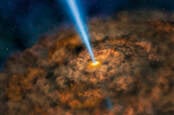This article is more than 1 year old
Astroboffins may have cracked the mystery of where the photons from weird gamma ray bursts come from
A quick flash can light up the observable universe
The photons streaming from mysterious gamma-ray bursts, the most energetic form of electromagnetic energy in the universe, break out from relativistic jets shooting out from dying supernova stars, according to the latest research.
GRBs were discovered when US satellites were searching for gamma radiation emitted from any nuclear weapons being tested in space in the 1960s. The military did detect signals, but they weren’t close to home. Instead, these swarms of gamma ray photons were coming from galaxies far away.
Scientists believe that the events, which can last anywhere from a few milliseconds to a few minutes, are produced from freak supernova explosions. Not all high mass stars ending their lives as supernova release gamma ray bursts – only ones that are particularly hefty where the old stellar core collapses straight into a black hole, skipping the neutron star phase.
The mechanism in how the radiation shoots out at speeds close to the speed of light, however, is still unknown. A team of astrophysicists led by Riken, a research lab in Japan, believe they have come closer to explaining the phenomenon.

Neutron star crash in a galaxy far, far... far away spews 'faster than light' radio signal jets at Earth
READ MOREThey simulated the radiation and motion of the 3D relativistic jets from supernovas using three supercomputers: A Cray XC30 and XC50 at the National Astronomical Observatory of Japan and the Hokusai BigWaterfall system at RIKEN. The model, published in Nature Communications, found that the gamma ray photons are emitted from the photosphere region of a jet ejected from a supernova close to the speed of light.
The jets, made out of ionized matter left over from a dead star, slowly expand as they travel in space. The material in the plume becomes less dense, and it becomes easier for the gamma ray photons to escape as there are fewer particles around to scatter off.
This kickstarts a sort of chain reaction as the material from regions with higher density begins to flood the regions that are less dense, creating more gaps for more gamma ray photons to leave.
"To us this strongly suggests that photospheric emission is the emission mechanism of GRBs," said Hirotaka Ito, first author of the paper and a research scientist at Riken.
"While we have elucidated the origin of the photons, there are still mysteries concerning how the relativistic jets themselves are generated by the collapsing stars. Our calculations should provide valuable insights for looking into the fundamental mechanism behind the generation of these tremendously powerful events," he concluded. ®
